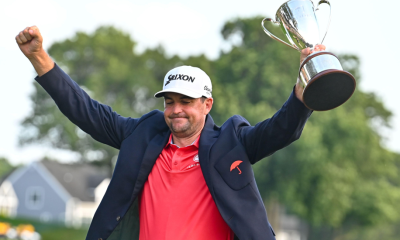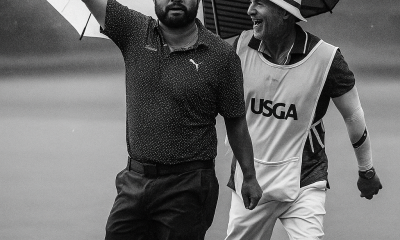Opinion & Analysis
Match play can work for the Tour with a little tinkering

As golf fans, we are seldom exposed to the extremely electrifying format of match play golf. When such weeks arise on what has recently become a very full calendar of golf, it definitely sparks some more attention from the viewers, as we know we will get to witness a form of competition that is much different from our weekly dose of stroke play.
While the fans seem to love when the PGA Tour switches its scoreboard from “even” to “all square,” it appears that the actual Tour, or the gentlemen and ladies who represent it, might not feel as strongly as we do. It’s been just over a week since one of the most exciting renditions of the WGC-Accenture Match Play, where 23-year old Frenchman Victor Dubuisson had his “hello world” moment. After watching Dubuisson hit two of the most miraculous recovery shots that match play has ever seen, to the average viewer it seemed as though such a Sunday performance from Dubuisson and eventual champion Jason Day reinforced that this tournament is as alive and well as ever.
However, if last week at the Ritz Carlton Resort at Dove Mountain appeared to be really great for golf, and more specifically the match play event, then why did PGA Tour Commissioner Tim Finchem announce that the location and sponsor for next year’s championship is unknown?
Well, there isn’t too much to look into at this point as the details on the subject are far from concrete. However, from a sponsorship standpoint it’s pretty tough to wrap your head around the fact that half of the tournament’s field is on a plane home before the second round even begins. Even more so, from a TV perspective, it has to be difficult to get huge viewership when there are only four golfers to watch on Championship Sunday, especially when none of the names include Tiger, Rory or Phil.
When addressing the media on the subject on Championship Sunday in the desert last weekend, Finchem went on to say that “the idea that players can come and play a day and be gone has always been something that we kind of looked at and wondered whether another format would be (better).”
While Finchem went on to say that he wouldn’t assume they are going to change anything at this point, there have been conversations circulating about format change for the season’s first World Golf Championship, in an effort to keep the games top stars around for as long as possible. In his article on GolfChannel.com, Senior Writer Rex Hoggard made it known that a member of the PGA Tour Advisory Council confirmed the Tour has been looking to alter the format to 36 holes of stroke play, followed by a cut, with either the top-32 or top-16 players moving on to a match play format on the weekend.
So we have established some pretty basic points as to why a title sponsor might not be getting the bang for their buck when you look at the format of the WGC Match Play event. After all, the PGA Tour is a business. And as a business if something isn’t working, well then you better fix it. Out of principle, there are some people who may not agree with having a match play event that is actually half stroke play. But if it means seeing the best players in the world play for one more round, subsequently increasing viewership, revenue, and all that jazz, then sign me up!
Back to my point about the match play format, with regards to a regular Tour event, whereby only four players are left for the final round. If 4-to-6 hours of golf coverage is centered around one match, then shouldn’t that match mean a little more to the players, the viewers, the sponsors, etc., than every other Sunday on Tour? With the exception of the Volvo World Match Play Championship, a European Tour event that doesn’t attract the same star power as the WGC Match Play, we only get to see the best players in the world compete on in match play event one other week of the year — in the Ryder Cup or President’s Cup matches. The extreme sense of pride that comes with representing your country in these events, according to the players, undoubtedly outweighs the paycheck that comes with a victory at a regular Tour stop. But what if the payout for a match play event was substantially more than just your average $1 million-plus Sunday?
Since its inception in 2007, and including all of the changes to the format to the FedEx Cup playoffs, there always seems to be those who criticize how the Tour crowns its $10 million man. But the new format changes proposed by the Tour for the WGC Match Play would probably make the most amount of sense for the season-ending Tour Championship. Why not have the end of the season and The Playoffs, with one of the biggest purses in sports, end in dramatic fashion like the NCAA March Madness tournament? The first three Playoff events would remain the same, being played as stroke play events, while the Tour Championship could operate as a 32-man match play event. While it appears that people are not as interested in seeing a head-to-head match up for a regular event (even though the Match Play is a WGC), I am pretty confident that such a format — with $10 million on the line — would spark a greater interest level from the fans than the current finale to the PGA Tour season.
Opinion & Analysis
The 2 primary challenges golf equipment companies face

As the editor-in-chief of this website and an observer of the GolfWRX forums and other online golf equipment discourse for over a decade, I’m pretty well attuned to the grunts and grumbles of a significant portion of the golf equipment purchasing spectrum. And before you accuse me of lording above all in some digital ivory tower, I’d like to offer that I worked at golf courses (public and private) for years prior to picking up my pen, so I’m well-versed in the non-degenerate golf equipment consumers out there. I touched (green)grass (retail)!
Complaints about the ills of and related to the OEMs usually follow some version of: Product cycles are too short for real innovation, tour equipment isn’t the same as retail (which is largely not true, by the way), too much is invested in marketing and not enough in R&D, top staffer X hasn’t even put the new driver in play, so it’s obviously not superior to the previous generation, prices are too high, and on and on.
Without digging into the merits of any of these claims, which I believe are mostly red herrings, I’d like to bring into view of our rangefinder what I believe to be the two primary difficulties golf equipment companies face.
One: As Terry Koehler, back when he was the CEO of Ben Hogan, told me at the time of the Ft Worth irons launch, if you can’t regularly hit the golf ball in a coin-sized area in the middle of the face, there’s not a ton that iron technology can do for you. Now, this is less true now with respect to irons than when he said it, and is less and less true by degrees as the clubs get larger (utilities, fairways, hybrids, drivers), but there remains a great deal of golf equipment truth in that statement. Think about it — which is to say, in TL;DR fashion, get lessons from a qualified instructor who will teach you about the fundamentals of repeatable impact and how the golf swing works, not just offer band-aid fixes. If you can’t repeatably deliver the golf club to the golf ball in something resembling the manner it was designed for, how can you expect to be getting the most out of the club — put another way, the maximum value from your investment?
Similarly, game improvement equipment can only improve your game if you game it. In other words, get fit for the clubs you ought to be playing rather than filling the bag with the ones you wish you could hit or used to be able to hit. Of course, don’t do this if you don’t care about performance and just want to hit a forged blade while playing off an 18 handicap. That’s absolutely fine. There were plenty of members in clubs back in the day playing Hogan Apex or Mizuno MP-32 irons who had no business doing so from a ballstriking standpoint, but they enjoyed their look, feel, and complementary qualities to their Gatsby hats and cashmere sweaters. Do what brings you a measure of joy in this maddening game.
Now, the second issue. This is not a plea for non-conforming equipment; rather, it is a statement of fact. USGA/R&A limits on every facet of golf equipment are detrimental to golf equipment manufacturers. Sure, you know this, but do you think about it as it applies to almost every element of equipment? A 500cc driver would be inherently more forgiving than a 460cc, as one with a COR measurement in excess of 0.83. 50-inch shafts. Box grooves. And on and on.
Would fewer regulations be objectively bad for the game? Would this erode its soul? Fortunately, that’s beside the point of this exercise, which is merely to point out the facts. The fact, in this case, is that equipment restrictions and regulations are the slaughterbench of an abundance of innovation in the golf equipment space. Is this for the best? Well, now I’ve asked the question twice and might as well give a partial response, I guess my answer to that would be, “It depends on what type of golf you’re playing and who you’re playing it with.”
For my part, I don’t mind embarrassing myself with vintage blades and persimmons chasing after the quasi-spiritual elevation of a well-struck shot, but that’s just me. Plenty of folks don’t give a damn if their grooves are conforming. Plenty of folks think the folks in Liberty Corner ought to add a prison to the museum for such offences. And those are just a few of the considerations for the amateur game — which doesn’t get inside the gallery ropes of the pro game…
Different strokes in the game of golf, in my humble opinion.
Anyway, I believe equipment company engineers are genuinely trying to build better equipment year over year. The marketing departments are trying to find ways to make this equipment appeal to the broadest segment of the golf market possible. All of this against (1) the backdrop of — at least for now — firm product cycles. And golfers who, with their ~15 average handicap (men), for the most part, are not striping the golf ball like Tiger in his prime and seem to have less and less time year over year to practice and improve. (2) Regulations that massively restrict what they’re able to do…
That’s the landscape as I see it and the real headwinds for golf equipment companies. No doubt, there’s more I haven’t considered, but I think the previous is a better — and better faith — point of departure when formulating any serious commentary on the golf equipment world than some of the more cynical and conspiratorial takes I hear.
Agree? Disagree? Think I’m worthy of an Adam Hadwin-esque security guard tackle? Let me know in the comments.
@golfoncbs The infamous Adam Hadwin tackle ? #golf #fyp #canada #pgatour #adamhadwin ? Ghibli-style nostalgic waltz – MaSssuguMusic
Podcasts
Fore Love of Golf: Introducing a new club concept

Episode #16 brings us Cliff McKinney. Cliff is the founder of Old Charlie Golf Club, a new club, and concept, to be built in the Florida panhandle. The model is quite interesting and aims to make great, private golf more affordable. We hope you enjoy the show!
Opinion & Analysis
On Scottie Scheffler wondering ‘What’s the point of winning?’

Last week, I came across a reel from BBC Sport on Instagram featuring Scottie Scheffler speaking to the media ahead of The Open at Royal Portrush. In it, he shared that he often wonders what the point is of wanting to win tournaments so badly — especially when he knows, deep down, that it doesn’t lead to a truly fulfilling life.
View this post on Instagram
“Is it great to be able to win tournaments and to accomplish the things I have in the game of golf? Yeah, it brings tears to my eyes just to think about it because I’ve literally worked my entire life to be good at this sport,” Scheffler said. “To have that kind of sense of accomplishment, I think, is a pretty cool feeling. To get to live out your dreams is very special, but at the end of the day, I’m not out here to inspire the next generation of golfers. I’m not out here to inspire someone to be the best player in the world, because what’s the point?”
Ironically — or perhaps perfectly — he went on to win the claret jug.
That question — what’s the point of winning? — cuts straight to the heart of the human journey.
As someone who’s spent over two decades in the trenches of professional golf, and in deep study of the mental, emotional, and spiritual dimensions of the game, I see Scottie’s inner conflict as a sign of soul evolution in motion.
I came to golf late. I wasn’t a junior standout or college All-American. At 27, I left a steady corporate job to see if I could be on the PGA Tour starting as a 14-handicap, average-length hitter. Over the years, my journey has been defined less by trophies and more by the relentless effort to navigate the deeply inequitable and gated system of professional golf — an effort that ultimately turned inward and helped me evolve as both a golfer and a person.
One perspective that helped me make sense of this inner dissonance around competition and our culture’s tendency to overvalue winning is the idea of soul evolution.
The University of Virginia’s Division of Perceptual Studies has done extensive research on reincarnation, and Netflix’s Surviving Death (Episode 6) explores the topic, too. Whether you take it literally or metaphorically, the idea that we’re on a long arc of growth — from beginner to sage elder — offers a profound perspective.
If you accept the premise literally, then terms like “young soul” and “old soul” start to hold meaning. However, even if we set the word “soul” aside, it’s easy to see that different levels of life experience produce different worldviews.
Newer souls — or people in earlier stages of their development — may be curious and kind but still lack discernment or depth. There is a naivety, and they don’t yet question as deeply, tending to see things in black and white, partly because certainty feels safer than confronting the unknown.
As we gain more experience, we begin to experiment. We test limits. We chase extreme external goals — sometimes at the expense of health, relationships, or inner peace — still operating from hunger, ambition, and the fragility of the ego.
It’s a necessary stage, but often a turbulent and unfulfilling one.
David Duval fell off the map after reaching World No. 1. Bubba Watson had his own “Is this it?” moment with his caddie, Ted Scott, after winning the Masters.
In Aaron Rodgers: Enigma, reflecting on his 2011 Super Bowl win, Rodgers said:
“Now I’ve accomplished the only thing that I really, really wanted to do in my life. Now what? I was like, ‘Did I aim at the wrong thing? Did I spend too much time thinking about stuff that ultimately doesn’t give you true happiness?’”
Jim Carrey once said, “I think everybody should get rich and famous and do everything they ever dreamed of so they can see that it’s not the answer.”
Eventually, though, something shifts.
We begin to see in shades of gray. Winning, dominating, accumulating—these pursuits lose their shine. The rewards feel more fleeting. Living in a constant state of fight-or-flight makes us feel alive, yes, but not happy and joyful.
Compassion begins to replace ambition. Love, presence, and gratitude become more fulfilling than status, profits, or trophies. We crave balance over burnout. Collaboration over competition. Meaning over metrics.
Interestingly, if we zoom out, we can apply this same model to nations and cultures. Countries, like people, have a collective “soul stage” made up of the individuals within them.
Take the United States, for example. I’d place it as a mid-level soul: highly competitive and deeply driven, but still learning emotional maturity. Still uncomfortable with nuance. Still believing that more is always better. Despite its global wins, the U.S. currently ranks just 23rd in happiness (as of 2025). You might liken it to a gifted teenager—bold, eager, and ambitious, but angsty and still figuring out how to live well and in balance. As much as a parent wants to protect their child, sometimes the child has to make their own mistakes to truly grow.
So when Scottie Scheffler wonders what the point of winning is, I don’t see someone losing strength.
I see someone evolving.
He’s beginning to look beyond the leaderboard. Beyond metrics of success that carry a lower vibration. And yet, in a poetic twist, Scheffler did go on to win The Open. But that only reinforces the point: even at the pinnacle, the question remains. And if more of us in the golf and sports world — and in U.S. culture at large — started asking similar questions, we might discover that the more meaningful trophy isn’t about accumulating or beating others at all costs.
It’s about awakening and evolving to something more than winning could ever promise.






















Denzgolf
Mar 5, 2014 at 4:30 pm
Great idea for Fedex but rather than still run risk of losing top ranked in first round (and actually to keep MP format thought out) why not go down path of World cup soccer, 8 seeded pools of four (ranked by position in playoffs not world ranking) who each play 3 matchplay rounds with top 2 of each pool going through to 16 from where it becomes knockout. 7 rounds required, make it 8 with final as 36 holes. Now that’s either a lot of golf in four days or run it over 2 weeks at a course (32 down to 8 in week 1, 8 to winner Friday to Sunday – or 6 days in a week – it is for $10m. There’s a chance of 2 wins each by 3 of four players in a pool, but you just define beforehand that if that occurs the top two seeded from previous 3 playoff weeks go through. If desired to, reduce this risk by allowing all square finishes at 18 in pool matches for half points.
Denzgolf
Mar 6, 2014 at 3:45 pm
Obviously no one else really likes matchplay, not much but silence on this one???
Phil C.
Mar 5, 2014 at 4:04 pm
I’ve been mulling over the exact same thought for over a year dear author. I LOVE match play, love to play it, love to watch it, love the competitive clarity it brings among the players. And yet golf television starves me of it.
Some of the most fun you’ve ever had sports with your friends was this virtual boxing ring you would construct with the big greats. Kobe vs Lebron, Lakers vs Celtics, Manning vs Brady. What does the golfer talk about hanging out at the bar? Tiger-bash? A conversation on course conditions which makes you wonder why a grown adult would have passionate arguments about grass texture? There simply is no head to head competition. Why not? Purists argue that golf is a pristine pursuit solely existing between the golfer and the course. I like to believe that is only the first step toward what golf will finally be. They would say that Seve Ballesteros, the great spanish short gamer, would in the heat of competition engage in small slights to push his match play opponents on edge. If a match play opponent would call for a free drop on some questionable obstructions he would then turn prickly. Questioning putting order on the green, questioning his opponents club choices, and any other small things to cloud his opponents head. While off the course he’d be known to be a good guy, his competitive nature turned him so HE WASN’T AFRAID TO BE THE BAD GUY.
There is no “bad guy” in golf today. The closest thing we have is the disfunctional stockholm relationship we have with Tiger Woods. The golf channel tries to make the public care with a few 30 second bumpers describing the obscure names on the leaderboard, but to be honest the Joe Sunday watching isn’t going to care that Golfer #17 is a fade hitter from west palm florida if it has no interplay with any of the other golfers. And so it is shown on TV. Random golf shots here, random putt there. Golfer #1 hitting an approach, Golfer #32 out of a greenside bunker, Golfer #8 hitting out of the rough. No sense of where you are on the course (other than a small window indicating hole #), no sense of how you got there, and no sense of the gravity or brevity of the shot make shot play golf very difficult to watch. But I’ve got some ideas.
#1 Format Change
Tim Finchem must have stolen my bedside notebook because I have very similiar thoughts. Bring stroke play into the first 2 days. Match play into the final days. But here are the finer details. First 2 days the entire field plays 27 holes. Field is then cut to the top 32 players. Next day is stroke play, STROKE MATCHES PLAY TO 6 HOLES. 3 rounds of 6 hole matches are played to reduce the field to final four. Champ Sunday is the am 9 hole match to reduce the the final two, and then an afternoon 18 hole championship match.
The first two days are loaded more simply to help qualm the argument that match play victim to luck and circumstance. That a match was won or loss because of a favorable course condition that happened at the time, or less skilled opponent. My rebuttal to that is that the players have played 54 holes of golf. If they aren’t in position to have a chance to win at the title, why exactly are they there? And more importantly, why does there need to be TV coverage of them?
Match play hole count was reduced to 6 holes. To put it simply, MAKE EACH SHOT MATTER. The argument again, is that 6 holes is not enough time for evaluation of skill. But SKILL has already been evaluated with the first 2 days, now it is time to test the players ability to deal with PRESSURE. To deal with the moment that you’re stuck in the bushes on your last hole with your opponent on the green, and your options are exhausted. Take the drop you lose. re-hit your last shot with penalty you lose. You’re simply forced into an arena where the only ticket out is the amazing. And if we do not put players into such duress, we’re never going to see such amazing shots.
All in all the big thing is to try and get more viewership to the game and help this game survive. Less dads and moms are playing golf and that means less kids will even be aware of the sport. I really do love this game, I just wish it wasn’t so laborious to watch it…